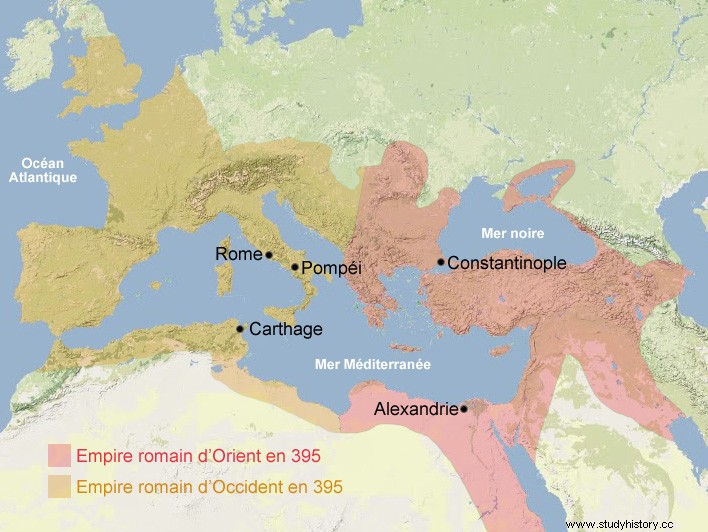
AROUND 200 AP. AD:The Roman Empire begins to weaken:
The Roman armies decide to choose their own emperors and fighting breaks out between different groups of soldiers. This marks the beginning of the fall of Rome.
The Roman Empire is attacked by the Germans:
The Germans are tribes from the northeast that the Romans call barbarians .
EN 284 AP. AD:General Diocletian becomes emperor:
To defend the Roman Empire against the barbarians , he reorganized the army and enlarged it.
EN 286 AP. AD:Emperor Diocletian splits the Roman Empire in two:
He realizes that the Roman Empire is too big for one person to control and he splits it in two. He governs the eastern part , while Emperor Maximian rules the western part .
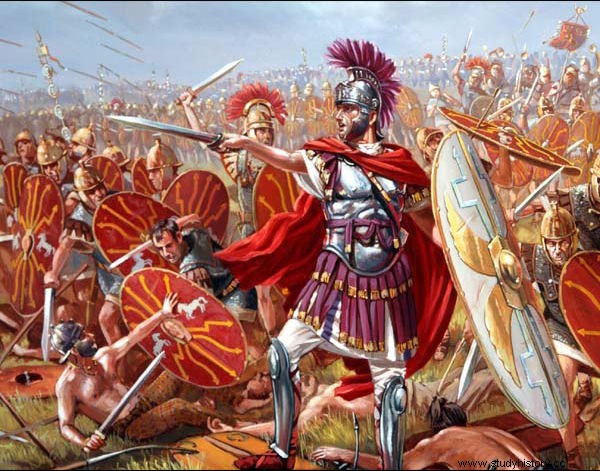
EN 312 AP. AD:Constantine becomes Emperor of the Western Roman Empire and legalizes Christianity:
When Emperor Diocletian dies, struggles to seize power resume. At that time the emperors who wanted to convey a message used their dreams or divine apparitions. Constantine is an ambitious Roman general who, after having a vision of a luminous cross in the sky, sends his army into battle with the chrism engraved on the shields. Constantine defeats Maxentius in the Battle of the Milvian Bridge , which allows him to seize Italy and reign supreme over the West. He becomes the first Roman emperor to convert to Christianity and allows Christians to worship without having to hide.
EN 324 AP. AD:Constantine reunites the Roman Empire:
He also seizes the Eastern Roman Empire and reunites the empire. He moves the capital to the city of Byzantium, south of the Black Sea on the shores of the Bosphorus. He rebuilt it, filled it with treasures brought from the 4 corners of the empire and renamed it after his own name:Constantinople . It promotes the spread of Christianity in Europe by attributing its victories to god and built the first churches . He grants Christians certain privileges and built many places of worship that promote the spread of Christianity throughout the Roman Empire. This brings a new turn both political and religious.

TOWARDS 370-382 AD. AD:The Germans are pushed back into Roman territory by the Huns:
Eastern Europe is invaded by the Huns and as they progress they drive the Germans out of their lands by pushing them back towards the Roman Empire.
EN 382 AP. J.-C.:The Visigoths invade the Roman lands:
The Visigoths, a Germanic barbarian tribe, arrive in peace and as good Christians on Roman lands. They say they want a better future for their families and Emperor Theodosius I allows them to settle in Moesia (south of the Danube) in exchange for their cooperation in fighting against other barbarian tribes. He leaves them their weapons, but the Visigoths are numerous and once they enter Roman lands, they show xenophobia, they enslave people, practice racketeering and generate new wars.
EN 391 AP. AD:Christianity becomes the official religion of the Roman Empire
Emperor Theodosius makes Christianity the official religion of the Roman Empire.
EN 395 AP. J.-C.:The Roman Empire is definitely divided into 2:
From that time, waves of barbarian tribes follow one another through the western part of the Roman Empire. They want to be as rich as the Romans and they are destroying Roman culture. They mostly inhabit small farming villages and let the Roman towns fall into ruin.
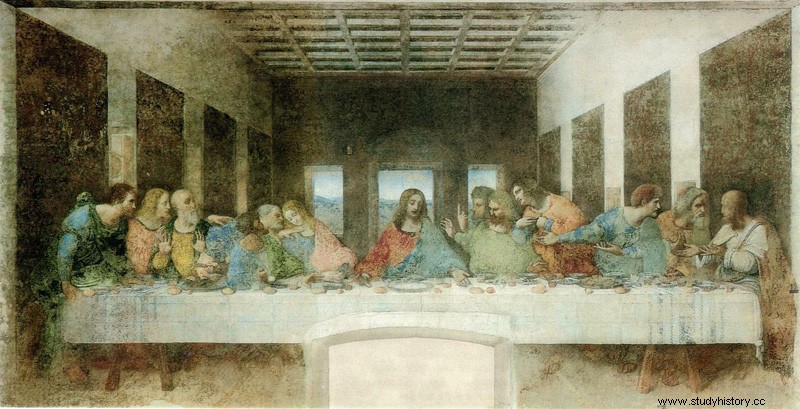
IN 400 AP. J.-C.:From the 5th century, two great divisions of Christianity oppose each other:
The Christian Church is recognized in more and more regions, but internal conflicts and cultural differences shape its various faces. The local Churches and the pagan peoples have the same beliefs but practice different rites. It is then that two large groups oppose each other:That of the Eastern Churches (Byzantine, Alexandrian, Armenian, Antiochian rites, etc.) and that of the Western Churches (Roman, Hispano-Visigothic, Gallicano-Gothic, Celtic rites, etc.).
Evolution of Christianity:
The major cities of the Roman world disputed the primacy of the Christian Churches and five patriarchs divided up the areas of influence (Rome for the West and Constantinople, Antioch, Jerusalem and Alexandria for the East). This causes opposition, especially at the level of languages and the liturgical calendar:
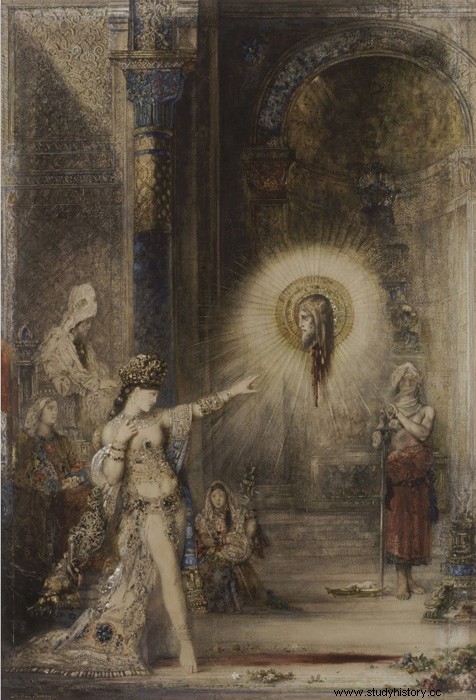
– Pope Damasus (366-384) accentuates the originality of the Roman Church by adopting Latin as the liturgical language instead of Greek.
– Everywhere the pivot of the ecclesiastical year is the Easter strong> , in spring. But as far as winter is concerned, the Churches of the East make Epiphany the manifestation of God on earth, celebrated on January 6, when Rome favors the celebration of the birth of Christ , fixed on December 25, the date of the ancient pagan feast of Sol invictus (“unconquered Sun” in Latin, is a solar deity who appeared in the Roman Empire in the 3rd century and takes on aspects, very popular in the Roman army , the mythology of Apollo and the cult of Mithras.
– Disputes break out over a new issue, that of the nature of Jesus Christ :Nestorianism is a doctrine that affirms that two persons, one divine, the other human, coexist in Jesus Christ, and that he is therefore both God and man. Arianism is a doctrine that affirms that even if God is divine, his son is a human above all, having a share of divinity. This doctrine disapproves of the popular designation of “Mary mother of God” and considers that she is the “mother of the man Jesus”. Monophysism is a doctrine that affirms that Christ has only one nature and that it is divine, the latter having absorbed his human nature. For adhering to such doctrines, some are exiled, condemned by the Church, or excommunicated (excluded from the Christian community). Some Christian Churches thus separate themselves from the common core, some choosing Monophysitism and others Nestorianism.
For all Christians , the baptism , the monastic life and the Eucharistic meal , reproducing the Last Supper, are the foundation of spiritual life. Another great sacrament is that of penance:The sinner, in order to be reinstated in the bosom of the Church, must submit in public to painful trials, before receiving reconciliation in a solemn ceremony.
Evangelization of pagan peoples:
The Church has a duty of evangelization. Among the missionaries responsible for converting peasants to Christianity, the most famous is Saint Martin , bishop of Tours, thanks to whom the Gallic villages were Christianized between 370 and 397 AD Persia, Syria, Mesopotamia, Anatolia, Central Asia, Armenia (converted since the 3rd century ), Georgia, Germany, Ethiopia, Ireland (Converted by Saint Patrick*) converted to Christianity and sometimes adopted a particular liturgy.
Saint Patrick :On March 17, Ireland solemnly celebrates the one who converted it to Christianity.
EN 406 AP. J.-C.:Hordes of barbarians rush into Italy:
The borders of the Rhine give way under the pressure of thousands of Germanic barbarians , Vandals, Suevi and Alans . The latter, with their herds, their families and their goods piled up on carts, flee, terrified by the irruption of the Huns. During this great invasion, the Vandals take the lead of the Suevi and the Alans. The Germans impose their traditions and are more and more numerous. They live in tribes and not in cities. They continue to barter and do not participate in the Roman monetary process.
EN 410 AP. J.-C.:The Visigoths seize Rome:
Under the leadership of their king Alaric, the Visigoths attack Rome that they ravage. After that, the Roman imperial power in the West is reduced to a shadow while puppet emperors and ursupators follow one another. They pale in comparison to the great Germanic leaders, such as the Visigoth Theodoric I or the Vandal Genseric . Aetius will be the last Roman senator.
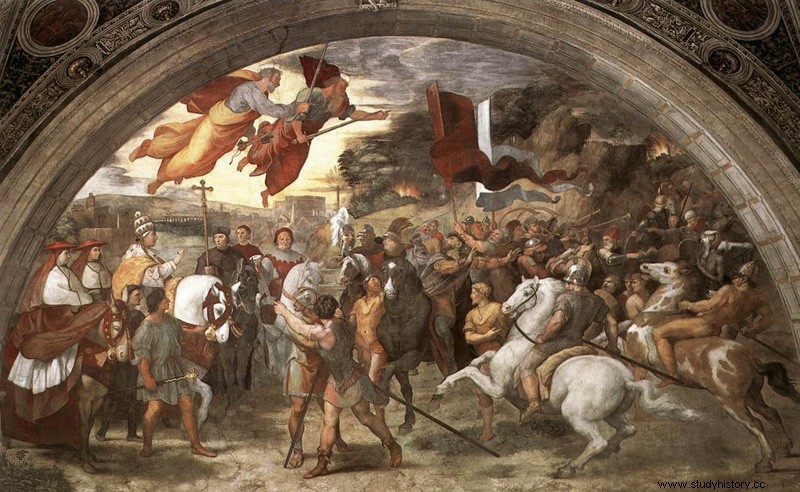
In 452:Italy is stormed by Attila the Huns:
Attila the Hun captures the trading city of Aquileia after a siege of several months, then devastates Milan, Padua, Pavia and Ravenna. He also tries to seize Rome , but after negotiations with Bishop Leon the Great , he finally left Italy in exchange for a heavy tribute.
EN 455 AP. AD:Destruction of Rome
The Vandals destroy Rome .
From 456 to 472:The Sue German Ricimer succeeds the Roman Aetius:
Ricimer becomes the true master of the Roman Empire. He appoints or dismisses emperors as he pleases.
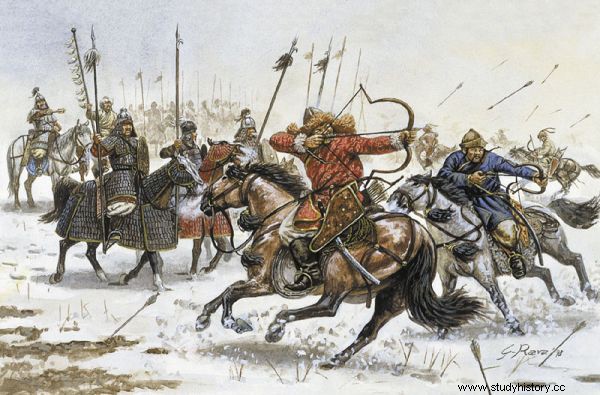
EN 476 AP. AD:Fall of Rome, collapse of the Western Roman Empire:
As civil wars break out, the Romans see their power decline in the West. Germanic peoples settle as conquerors in the imperial provinces and found new kingdoms there. The leader of the Visigoths, Odoacer, proclaims himself king of Italy and the Western Roman Empire comes to an end.
The Eastern Roman Empire will resist another 1000 years:
It is called Byzantine Empire because its capital Constantinople, was originally called Byzantium. The Romans no longer know how to govern and no longer want conquests. For some, it is a constant decline over several centuries which begins, for others, a transition from ancient culture to a new European culture.
From 493 to 555:Kingdom of the Ostrogoths in Italy:
The Germans become masters of the West and the unity of the Roman world is definitively broken.
Learn more about Christians and the Middle East during antiquity.
Learn more about the barbarians Visigoths, Huns, Vandals, Scythians, Alans and Europe during antiquity.
